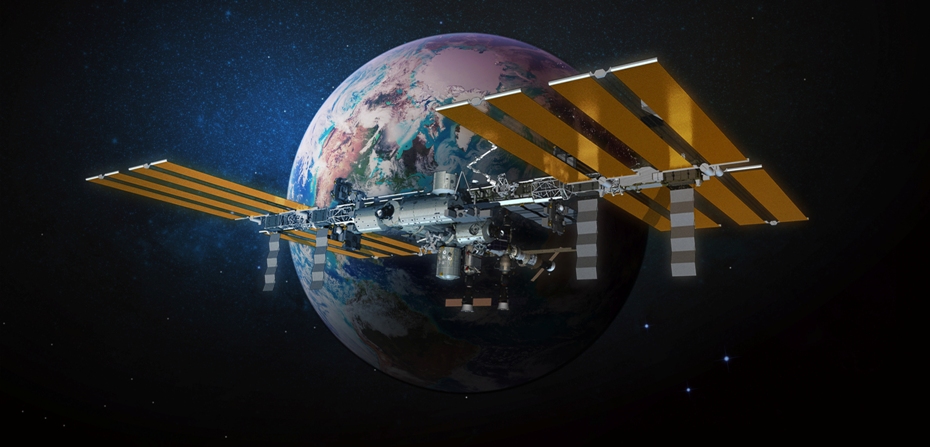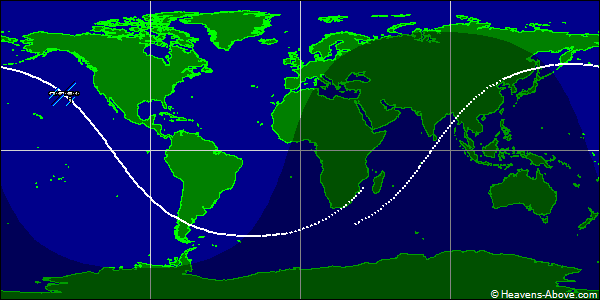ISS has already completed 100,000 turns around the Earth.

While we are reading our resource, sitting in a work chair, lying on a home couch, standing in public transport - several people from all the vast humanity are in a unique position. They constantly fly at an altitude of 330-430 kilometers above the surface of our planet and are the envoys of mankind in outer space. These people are astronauts, temporary inhabitants of the International Space Station, which this weekend mid-May makes a hundred-thousandth revolution around the Earth (*).
In the 1980s, the American elite became very interested in obtaining the US military advantage in orbit. The then President Reagan in 1983 announced the creation of a long-term program of research and development called "Strategic Defense Initiative . "
SOI was to develop a space-based missile defense system that would create a space shield over the US. It was assumed that innovative satellites located on satellites (based on radial, electromagnetic, kinetic, microwave principles, as well as weapons of the new generation “earth-space”, “air-space”) would knock down potential enemy missiles (in the role of which acted the USSR).
According to some military experts, the name of the program that would more accurately convey the essence of the program would be “strategic initiative defense,” that is, defense, which implies the implementation of independent active actions, up to and including attack.
Fortunately, this program did not come true - apart from complex scientific and technical problems, its development faced a socio-psychological factor - the presence of powerful and practically all-powerful weapons in space. As a result, plans to create a PIO have come to give up.

But in the wake of a rising interest in space, Reagan in 1984 announced the start of work on the creation of the American space station "Freedom". Initially, it was a joint project of the United States, Europe, Canada and Japan. By the early 1990s, it turned out that the cost of developing a project was too high and only international cooperation would allow the creation of such a station.
At the same time, the USSR, which already had experience in creating and launching the Salyut orbital stations, as well as the Mir station, planned to create the Mir-2 station, but due to economic difficulties the project was suspended.
However, the USSR collapsed in 1991, and already Russia began to negotiate with the United States about the flights of American space shuttles to the Mir station - and in the process of discussing this issue the idea of a joint space station was born. This proposal almost failed in the US Congress - the proposal to refuse to cooperate with Russia did not pass, thanks to a margin of only one vote.
By 1996, the station configuration was approved, consisting of one Russian segment and one segment from the United States with the participation of allies (Canada, Japan, Italy, etc.).

The first element of the ISS, the functional cargo block Zarya, was launched by the Russian Proton-K rocket (FGB) on November 20, 1998 — this date is considered the beginning of the station’s operation. The first people appeared on it in December 1998, when the shuttle Endeavor docked the American Unity module (Unity, Node-1) to the Zarya module. On December 10, 1998, astronauts from the USA and Russia entered the station.
Since then, the station has constantly overgrown with new equipment and new modules, has visited more than 200 cosmonauts(most of them were from the USA and Russia), 8 space tourists, organized a correspondence wedding (cosmonaut Yuri Malenchenko, who was at the station, married Ekaterina Dmitrieva from Texas, who was on Earth, and according to the laws of the state of Texas, this ceremony was recognized as legitimate) and conducted a huge number of scientific experiments in the field of geophysics, medicine, biology, the study of the solar system, etc.
With the ISS, there are occasional online video broadcasts in which fans often see UFOs. However, it usually turns out to be either reflections and glare, or space debris.
Despite the large amount of this very garbage, its collisions with the ISS are quite rare. The ISS is constantly undertaking maneuvers to avoid collisions with large debris, and small ones are caught less often. In 2013, a tiny “pebble from space” broke through a solar panel, and two days ago one fragment , no larger than a grain of sand, managed to break a window in the Dome module.
ISS is constantly criticized. In the US, it is criticized for its high cost and argue that unmanned flights into near space or other scientific projects conducted on Earth would give much more return. Russian criticism is more directed towards insufficient upholding of national interests. Also heard requirements for the organization of its own, independent project of the orbital station.
Nevertheless, the station is a good example of the collaboration of many countries, and shows that organizing really great things does not require rivalry, but cooperation.
(*) According to different data, the speed of the ISS is different. For example, in the Russian Wiki there are 6385 days in orbit and 15.5 revolutions per day, which gives 98967 revolutions - while the number of revolutions in a separate column is already 100,563 times.
